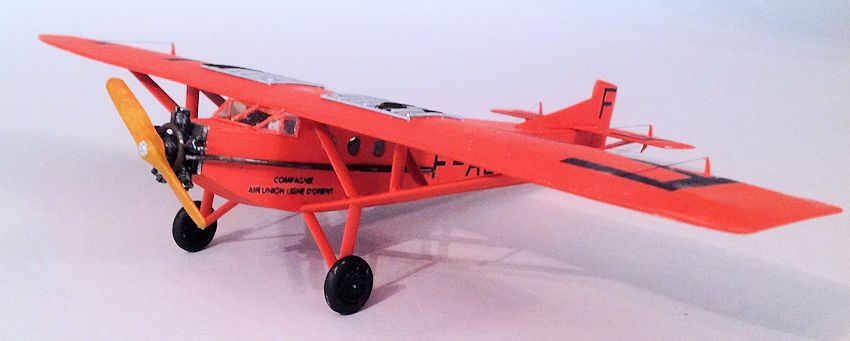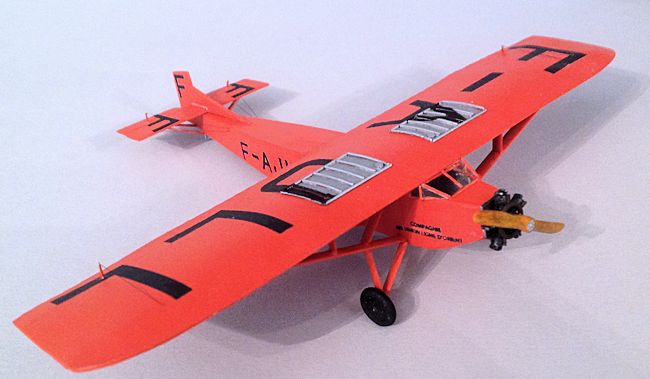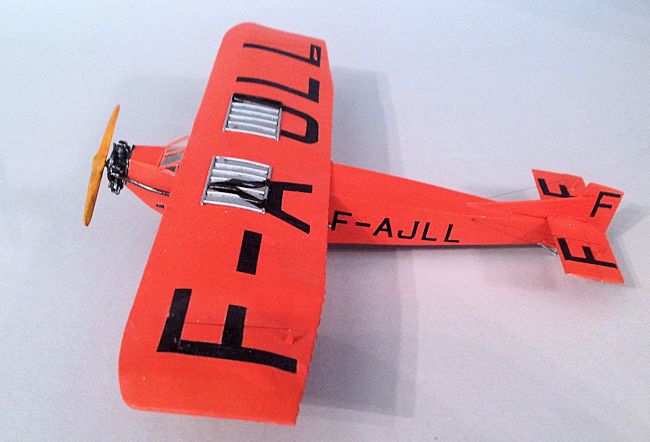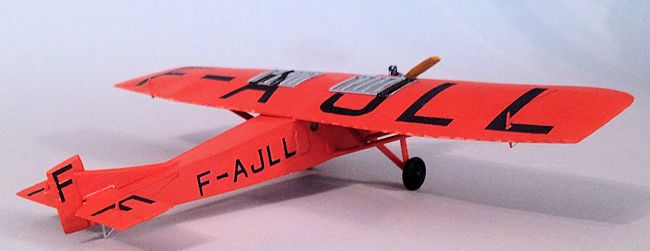
1/72 Farman F 190
| KIT #: | |
| PRICE: | Cheap |
| DECALS: | |
| REVIEWER: | Chris Peachment |
| NOTES: | Scratch-built using plastic card and rod. |

| HISTORY |
Having built the Farman Jabiru, and the Farman Flying Fish
for this website some months ago, I began to surfing for other examples of the
Farman aircraft and what soon came up was the F 190, a
passenger and utility aircraft built in the 20s and 30s. It was a high-wing
conventional monoplane of with enclosed cabin and fixed undercarriage with tail
skid. It was very popular both as an air taxi and also a private aircraft.
Thirty examples were operated by airlines in France and Europe. Fiftee n of
these were in the Air France fleet from 1933, and there was an air ambulance
version, the F 197S (for "Sanitaire")
with two litters and an attendant.
n of
these were in the Air France fleet from 1933, and there was an air ambulance
version, the F 197S (for "Sanitaire")
with two litters and an attendant.
Like every other aircraft of this period, they were also
used in the Spanish Civil War, so you can make a camouflaged one if you like.
My model represents the F190 in the markings of Air Union
Lignes d'Orient 1930, Mission d’étude Paris-Hanoi, which flew a route from Paris
to what was then Indo-China, later Vietnam.
The 190 came with a number of engine variants. Mine has
the 230 hp five cylinder Gnome Rhone. Many others used a larger Salmson or
Hispano Suiza engine.
It is a handsome aircraft with clean square cut lines, which make scratch building all the easier because of few compound curves. Even the windscreen is flat, so there is no need for plunge moulding. A term which grips my entrails with ice cold fingers of steel.
| CONSTRUCTION |
I found a card model website which happened to have free
downloadable plans which can be photocopied onto card, and then folded and glued
to make a nice looking card model of the Farman. Card modelling does seem to be
coming on apace, and I have seen some excellent examples on various websites
which could be said to rival their plastic equivalents. Never having tried it,
however, I stuck with what I know.
 The card cut out model provided very good templates for
tacking onto plastic card with some blue-tack and then cutting out. I also used
this very nice orange-red example (there are a variety of markings) to make
decal markings. Simply put the plans on top of a photocopier and run a blank
sheet of decal paper through instead of ordinary paper. It won't print white of
course, but that didn't matter here.
The card cut out model provided very good templates for
tacking onto plastic card with some blue-tack and then cutting out. I also used
this very nice orange-red example (there are a variety of markings) to make
decal markings. Simply put the plans on top of a photocopier and run a blank
sheet of decal paper through instead of ordinary paper. It won't print white of
course, but that didn't matter here.
The fuselage floor, sides and top were cut out first. Note
that there is a boat-like chine under the nose. A 'pie-slice” can be cut out of
the floor at the nose, pinched together and glued to form the chine.
The round windows must be cut from the sides at this point,
using a drill initially, and then a sharp scalpel.
I decided to detail the interior, and so some seats were
put together from card, and then an overhead luggage rack was woven from thin
string, some cushions for the seats made in fabric, hand painted a tartan
pattern, a magazine rack complete with some scaled down magazines, and a drinks
cabinet with a full compliment of 1/72 whisky and gin bottles and glasses made
from perspex. Sitting in one of the seats is a fashionable lady clad in furs,
with a small lapdog which is a 1/72 Chihuahua. Foolishly I forgot to add
interior lights, and so none of this can be seen. And you, dear readers, may now
all cry in unison “But it is nice to know that it is there.” The same with the
cockpit, although if you shine a powerful torch at the side screen, you can make
out that the interior colour is grey.
The wings were made in time honoured fashion. By which I
mean a thickish card underside, a rod for the spar laid across the span, abut
1/3 of the chord back from the leading edge, and then some thin card, scored
underneath for ribs, with a black biro and steel rule, is first glued to the
leading edge, than when set, folded over to the leading edge.
 The trailing edge has very small scallops in it. These are
best done now. I hadn't noticed them until I had almost finished. As a
consequence the upper wings near the tips have some interesting dents in them
from being gripped while cutting off the scallops. Careful analysis of existing
photos will reveal that most aircraft of this period had dents and ripples all
over them, from buffeting in the air, or rough handling on the ground. Alas,
mine just looked like dents in a model, so I filled them in as best I could with
filler, and left a few for weathering's sake. The tail planes can be cut from
solid card, scored for ribs, and elevators, and the rudder made separately
The trailing edge has very small scallops in it. These are
best done now. I hadn't noticed them until I had almost finished. As a
consequence the upper wings near the tips have some interesting dents in them
from being gripped while cutting off the scallops. Careful analysis of existing
photos will reveal that most aircraft of this period had dents and ripples all
over them, from buffeting in the air, or rough handling on the ground. Alas,
mine just looked like dents in a model, so I filled them in as best I could with
filler, and left a few for weathering's sake. The tail planes can be cut from
solid card, scored for ribs, and elevators, and the rudder made separately

| CONCLUSIONS |

I have not looked at Howard Hawks masterpiece, Only Angels
Have Wings, for a long time now. But I have a feeling that the sequence in which
a Doctor is flown in, might well have used a Farman F 190. If I am wrong, please
don't write to tell me. I plan to watch the film again soon.
| REFERENCES |
http://wp.scn.ru/en/ww15/t/1797/5329/0
http://wp.scn.ru/en/ww15/t/1797/238/0
http://beta4good.blogspot.co.uk/2011/04/more-about-virtuatea-aeronautica-order.html
http://www.ecardmodels.com/index.php/1-48-farman-f-190-f-aiyd-paper-model.html
http://www.airliners.net/photo/Farman-F.192/1732816/L/&sid=f52a4b00b2877d5006ea5057274ded23
http://arawasi-wildeagles.blogspot.co.uk/2012/11/visitors-french-connection.html
September 2014 If you would like your product reviewed fairly and fairly quickly, please
contact
the editor or see other details in the
Note to
Contributors.